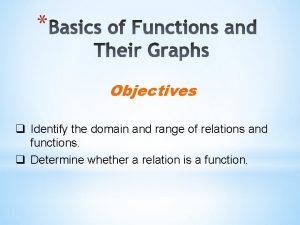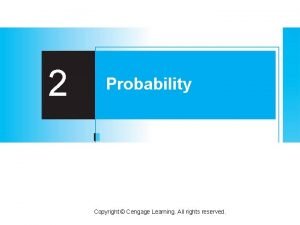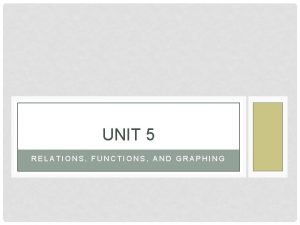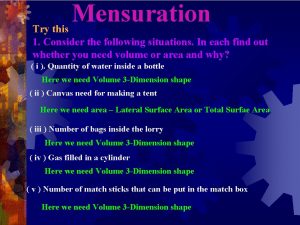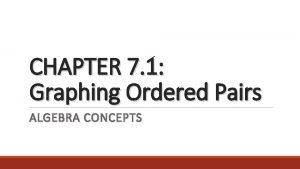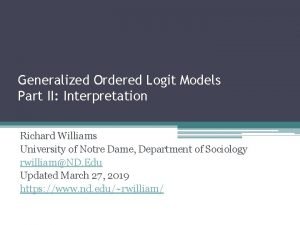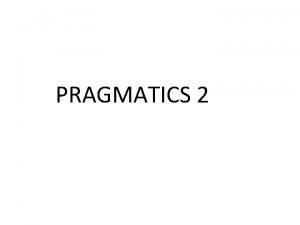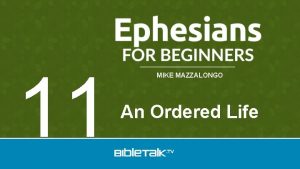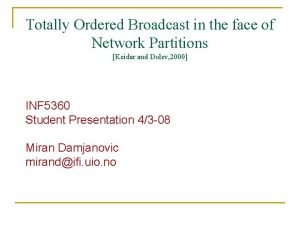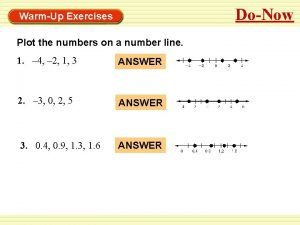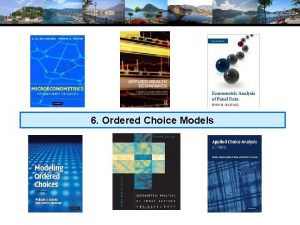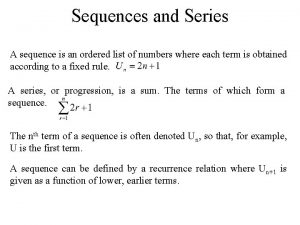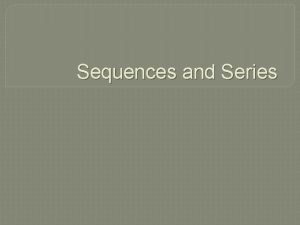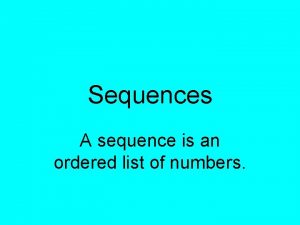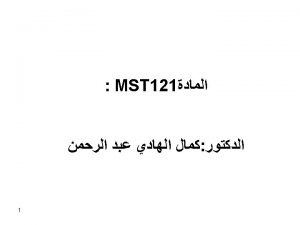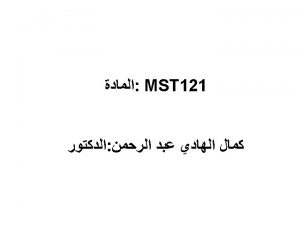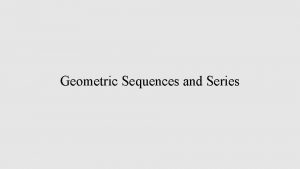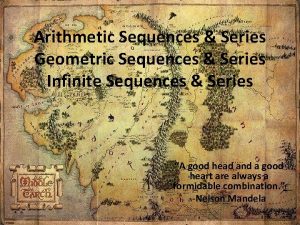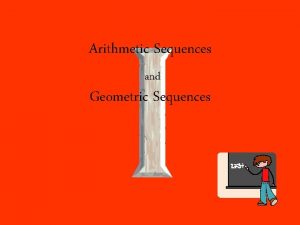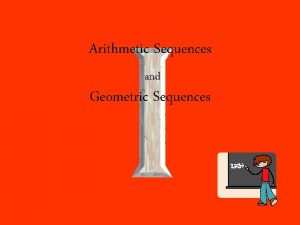A 1 SEQUENCES A sequence is an ordered

















- Slides: 17


A 1: SEQUENCES • A sequence is an ordered list of numbersfinite or infinite-called terms. • Notation: The nth term of a sequence is denoted by an. The subscript or suffix n indicates its position. The sequence itself is either denoted by a or (an). • Ex 1: a=(an)=(1, 4, 9, 16, 25): finite • Ex 2: b=(bn)=(1, 3, 5, 7, 9, …) infinite • Ex 3: c=(cn)=(3, -2, 2, 3, 2, 1)

Graph of a sequence: plotted by taking ordered pairs (n, an) for n in the domain of definition an . . n 1 2 3 4

• Describing sequences: • A closed form of a sequence is a rule or formula giving nth term an in term of n. • Eg in Ex 1: an=n 2, n=1, 2, 3, 4, 5… perfect squares. in Ex 2: bn=2 n+1, n=0, 1, 2, 3, … Or bn=2 n-1 n=1, 2, 3 odd numbers. • Convention: first term is usually taken as a 1(starting from n=1). • Sometimes we start from n=0, i. e. first term in a 0.

Examples: dn=1/n(n-1), n=2, 3, … un=(-1)n 1/n, n=1, 2, 3, …. • A recurrence relation: gives any term of the sequence in terms of the preceding term. (a first order recurrence relation). e. g. in Ex 2: bn=bn-1+2, n=1, 2, 3, … A recurrence system consists of a recurrence relation, the first term and an index range.

• Arithmetic sequences: are sequences where the difference between any two consecutive terms is constant-called the common difference and denoted by d. (Also called arithmetic progression) Example: Ex 2: bn=bn-1+2, here d=2.

• Arithmetic sequence: with first term a and difference d is given by the recurrence system: x 1=a, xn+1= xn+d, n=1, 2, 3…. • Parameters of the sequence are its first term a and difference d. • Closed from of an arithmetic sequence is • x 1=a, xn=a+(n-1)d, n=1, 2, 3… or alternatively x 0 =a, xn=a+nd, n=0, 1, 2… 7

• GEOMETRIC SEQUENCES: are sequence where the ratio between any two consecutive terms is constant- called the common ratio and denoted by r, (also called geometric progression). • Parameters are: first term a, common ratio r • Recurrence relation: x 1=a, xn+1=rxn, n=1, 2, 3, . . Or x 0=a, xn+1=rxn, n=0, 1, 2, . .

Example: xn+1=2 xn, n=1, 2, … If x 1=2 If x 1=3 (xn)=(2, 4, 8, 16…) (xn)=(3, 6, 12, 24, . . ) Closed from of a geometric sequence: x 1 =a, xn =arn-1 , n=1, 2, 3, … OR x 0=a, xn=arn, n=0, 1, 2, 3, …

• Sum Sn of first n terms of the geometric sequence xn=rn and first term =1: Sn= 1+r+r 2+…+rn-1. rsn= r+r 2+. . +rn-1+rn rsn—Sn=Sn(r-1)= rn-1 : . Sn = (rn-1 )/(r-1) or (1 -rn ) /(1 -r) , r≠ 1

• Linear Recurrence Sequences : each term is given as a linear function of the preceding term. • xn+1 = r xn +d , r , d constants , n = 1, 2, 3, … • Parameters are : first term a , ratio r and difference d.

• They generalize both arithmetic sequences and geometric sequence (special cases ). • (1) r =1 xn+1 =xn+d (arithmetic sequence ) (2) d = 0 xn+1 = rxn (geometric sequence). • Recurrence system : x 1 = a , xn+1 = rxn +d , n = 1, 2, 3, … or x 0 = a , xn+1 = rxn +d , n = 0, 1, 2, 3, . . • Closed form is x 1 = a , xn = (a+ d/(r-1) ) rn-1 – d/(r-1) , n=1, 2, 3, … or x 0 = a , xn = (a+ d/(r-1) ) rn – d/(r-1), n=0, 1, 2…

• Long term behaviour of sequences : For a sequence xn : as n → ∞ if xn → ℓ(i. e. xn become arbitrarily close to ℓ ) then we describe the long term ( or long run ) behaviour of the sequence by : xn → ℓ as n → ∞. equivalently written lim xn =ℓ. n ∞ Examples : 1) xn = k , constant : xn → k as n → ∞ 2) xn = 1/n , xn → 0 as n → ∞ 3) xn = n , xn → ∞ as n→ ∞

• For k >0 4) xn = nk xn -k , x 5) xn= 1= n n nk Rules : if xn (1) (xn ± yn ) (2) ( k xn ) (3) (xn. yn) (4) (xn /yn) ∞ as n 0 as n ∞ ∞ ℓ , yn m as n ∞ then. ( ℓ ± m ) as n ∞. kℓ as n ∞. ℓ. m as n ∞ ℓ / m m≠ 0 as n ∞

• • Examples : if an in a rational function of n: write an=P /Q , P, Q polynomials in n. I If degree(P) > degree(Q) then an →∞ as n→∞ II If degree (P) < degree (Q) then an → 0 as n→∞ III If degree (P)= degree (Q) then an → coefficient of highest power in P÷ coefficient of highest power in Q as n → ∞

Long term behaviour of rn : (Table) Range of r r >1 r=1 -1 < r < 1 Behaviour of rn rn →∞ as n →∞ rn → 1 as n→∞ rn → 0 as n →∞ r = -1 rn alternates between as n →∞ 1 and-1 , r < -1 rn is unbounded and alternates in sign as n→∞

A special limit • an=(1+1/n)n→e ~ 2. 718. . as n →∞. • bn = (1+x/n)n → ex as n →∞. Examble : ( 1 - 5/n )n → e-5 as n →∞ • Sequences and Models : (A 1 pp 36 -38 ) • Used Arithmetic sequence to model the book and oil sequences. • Used Geometric sequence to model the saving account and bouncing ball sequences. • Used linear recurrence sequence to model the deer population and mortgage sequences.
 A sequence is a list of ordered pairs.
A sequence is a list of ordered pairs. Selection in pseudocode
Selection in pseudocode Differentiate finite from infinite sequence
Differentiate finite from infinite sequence Convolutional sequence to sequence learning
Convolutional sequence to sequence learning Nucleotide to amino acid
Nucleotide to amino acid How to find domain and range
How to find domain and range Product rule for ordered pairs
Product rule for ordered pairs Ordered pairs that represent a function examples
Ordered pairs that represent a function examples A sports company was ordered to prepare 100 paper cylinders
A sports company was ordered to prepare 100 paper cylinders Ordered pair in algebra
Ordered pair in algebra Interpretation of linear probability model
Interpretation of linear probability model An ordered arrangement
An ordered arrangement Presupposition and entailment
Presupposition and entailment An ordered life
An ordered life Ordered broadcast
Ordered broadcast Which ordered pair is a solution of the equation
Which ordered pair is a solution of the equation Ordered matrix
Ordered matrix Formula hipotenusa triangle rectangle
Formula hipotenusa triangle rectangle





